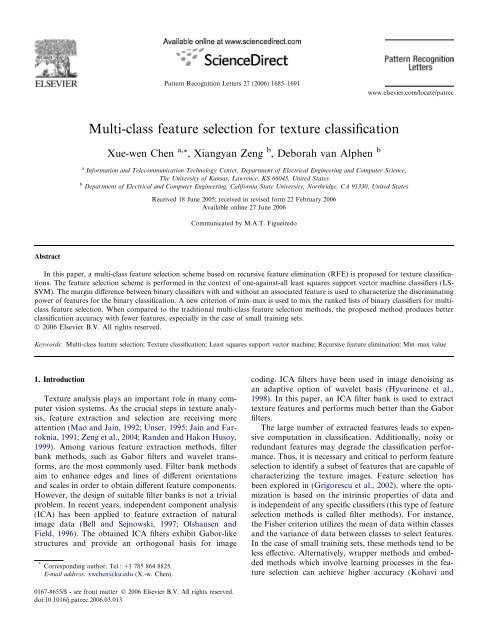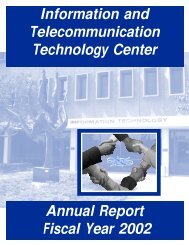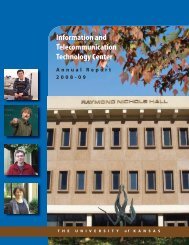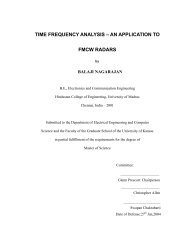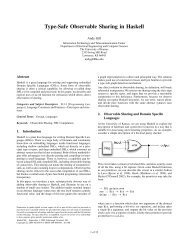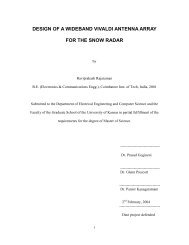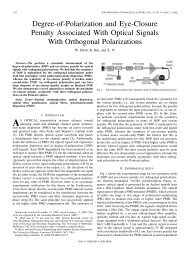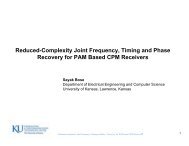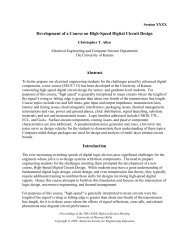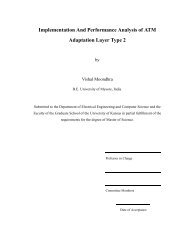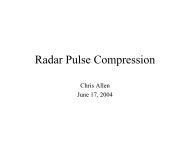Multi-class feature selection for texture classification
Multi-class feature selection for texture classification
Multi-class feature selection for texture classification
You also want an ePaper? Increase the reach of your titles
YUMPU automatically turns print PDFs into web optimized ePapers that Google loves.
Pattern Recognition Letters 27 (2006) 1685–1691<br />
www.elsevier.com/locate/patrec<br />
<strong>Multi</strong>-<strong>class</strong> <strong>feature</strong> <strong>selection</strong> <strong>for</strong> <strong>texture</strong> <strong>class</strong>ification<br />
Xue-wen Chen a, *, Xiangyan Zeng b , Deborah van Alphen b<br />
a In<strong>for</strong>mation and Telecommunication Technology Center, Department of Electrical Engineering and Computer Science,<br />
The University of Kansas, Lawrence, KS 66045, United States<br />
b Department of Electrical and Computer Engineering, Cali<strong>for</strong>nia State University, Northridge, CA 91330, United States<br />
Received 18 June 2005; received in revised <strong>for</strong>m 22 February 2006<br />
Available online 27 June 2006<br />
Communicated by M.A.T. Figueiredo<br />
Abstract<br />
In this paper, a multi-<strong>class</strong> <strong>feature</strong> <strong>selection</strong> scheme based on recursive <strong>feature</strong> elimination (RFE) is proposed <strong>for</strong> <strong>texture</strong> <strong>class</strong>ifications.<br />
The <strong>feature</strong> <strong>selection</strong> scheme is per<strong>for</strong>med in the context of one-against-all least squares support vector machine <strong>class</strong>ifiers (LS-<br />
SVM). The margin difference between binary <strong>class</strong>ifiers with and without an associated <strong>feature</strong> is used to characterize the discriminating<br />
power of <strong>feature</strong>s <strong>for</strong> the binary <strong>class</strong>ification. A new criterion of min–max is used to mix the ranked lists of binary <strong>class</strong>ifiers <strong>for</strong> multi<strong>class</strong><br />
<strong>feature</strong> <strong>selection</strong>. When compared to the traditional multi-<strong>class</strong> <strong>feature</strong> <strong>selection</strong> methods, the proposed method produces better<br />
<strong>class</strong>ification accuracy with fewer <strong>feature</strong>s, especially in the case of small training sets.<br />
Ó 2006 Elsevier B.V. All rights reserved.<br />
Keywords: <strong>Multi</strong>-<strong>class</strong> <strong>feature</strong> <strong>selection</strong>; Texture <strong>class</strong>ification; Least squares support vector machine; Recursive <strong>feature</strong> elimination; Min–max value<br />
1. Introduction<br />
Texture analysis plays an important role in many computer<br />
vision systems. As the crucial steps in <strong>texture</strong> analysis,<br />
<strong>feature</strong> extraction and <strong>selection</strong> are receiving more<br />
attention (Mao and Jain, 1992; Unser, 1995; Jain and Farroknia,<br />
1991; Zeng et al., 2004; Randen and Hakon Husoy,<br />
1999). Among various <strong>feature</strong> extraction methods, filter<br />
bank methods, such as Gabor filters and wavelet trans<strong>for</strong>ms,<br />
are the most commonly used. Filter bank methods<br />
aim to enhance edges and lines of different orientations<br />
and scales in order to obtain different <strong>feature</strong> components.<br />
However, the design of suitable filter banks is not a trivial<br />
problem. In recent years, independent component analysis<br />
(ICA) has been applied to <strong>feature</strong> extraction of natural<br />
image data (Bell and Sejnowski, 1997; Olshausen and<br />
Field, 1996). The obtained ICA filters exhibit Gabor-like<br />
structures and provide an orthogonal basis <strong>for</strong> image<br />
* Corresponding author. Tel.: +1 785 864 8825.<br />
E-mail address: xwchen@ku.edu (X.-w. Chen).<br />
coding. ICA filters have been used in image denoising as<br />
an adaptive option of wavelet basis (Hyvarinene et al.,<br />
1998). In this paper, an ICA filter bank is used to extract<br />
<strong>texture</strong> <strong>feature</strong>s and per<strong>for</strong>ms much better than the Gabor<br />
filters.<br />
The large number of extracted <strong>feature</strong>s leads to expensive<br />
computation in <strong>class</strong>ification. Additionally, noisy or<br />
redundant <strong>feature</strong>s may degrade the <strong>class</strong>ification per<strong>for</strong>mance.<br />
Thus, it is necessary and critical to per<strong>for</strong>m <strong>feature</strong><br />
<strong>selection</strong> to identify a subset of <strong>feature</strong>s that are capable of<br />
characterizing the <strong>texture</strong> images. Feature <strong>selection</strong> has<br />
been explored in (Grigorescu et al., 2002), where the optimization<br />
is based on the intrinsic properties of data and<br />
is independent of any specific <strong>class</strong>ifiers (this type of <strong>feature</strong><br />
<strong>selection</strong> methods is called filter methods). For instance,<br />
the Fisher criterion utilizes the mean of data within <strong>class</strong>es<br />
and the variance of data between <strong>class</strong>es to select <strong>feature</strong>s.<br />
In the case of small training sets, these methods tend to be<br />
less effective. Alternatively, wrapper methods and embedded<br />
methods which involve learning processes in the <strong>feature</strong><br />
<strong>selection</strong> can achieve higher accuracy (Kohavi and<br />
0167-8655/$ - see front matter Ó 2006 Elsevier B.V. All rights reserved.<br />
doi:10.1016/j.patrec.2006.03.013
1686 X.-w. Chen et al. / Pattern Recognition Letters 27 (2006) 1685–1691<br />
John, 1997; Guyon and Elisseeff, 2004; Mao, 2004). Wrappers<br />
take the learning machine as a black box and evaluate<br />
<strong>feature</strong>s by <strong>class</strong>ification per<strong>for</strong>mance. They try to search<br />
<strong>for</strong> the optimal subset in combinatorial <strong>feature</strong> space,<br />
which leads to intensive computation. Embedded methods<br />
per<strong>for</strong>m <strong>feature</strong> <strong>selection</strong> in the process of training and<br />
reach a solution faster by avoiding retraining the learning<br />
machine when every <strong>feature</strong> is selected. For instance, the<br />
recursive <strong>feature</strong> elimination method (RFE) uses the<br />
change in objective functions when a <strong>feature</strong> is removed<br />
as a ranking criterion. With a backward elimination strategy,<br />
the <strong>feature</strong>s that contribute least to the <strong>class</strong>ification<br />
are removed iteratively. The RFE method is usually specific<br />
to the given learning machine. In this paper, we will<br />
adopt the RFE method to select <strong>texture</strong> <strong>feature</strong>s <strong>for</strong><br />
multi-<strong>class</strong> <strong>class</strong>ification.<br />
Texture <strong>feature</strong> <strong>selection</strong> is typically a multi-<strong>class</strong> problem.<br />
For multi-<strong>class</strong> <strong>feature</strong> <strong>selection</strong> problems, embedded<br />
methods either consider one single criterion <strong>for</strong> all the <strong>class</strong>es<br />
or decompose multi-<strong>class</strong> into several two-<strong>class</strong> problems.<br />
It has been pointed out that in the case of uneven<br />
distribution across <strong>class</strong>es, using one single criterion <strong>for</strong><br />
all the <strong>class</strong>es may over-represent easily separable <strong>class</strong>es<br />
(Forman, 2003). Alternatively, mixing the results of several<br />
binary <strong>class</strong>ifiers may yield better per<strong>for</strong>mance. To address<br />
this issue, Sindhwani et al. (2004) use the summation of the<br />
margin differences of all the binary <strong>class</strong>ifiers as a <strong>feature</strong><br />
<strong>selection</strong> criterion <strong>for</strong> the support vector machines (SVMs)<br />
and multi-layer perceptrons, and Weston et al. (2003) use<br />
the summation criterion <strong>for</strong> the multi-<strong>class</strong> case in their<br />
zero-norm learning algorithm.<br />
In this paper, we propose a new method to mix ranked<br />
<strong>feature</strong>s of several binary <strong>class</strong>ifiers. We use the maximum<br />
value of the margin differences of binary <strong>class</strong>ifiers<br />
to rank the <strong>feature</strong>s and omit ones with minimum values.<br />
Compared with the summation criterion, the maximum<br />
value is robust to oscillation. This is especially important<br />
<strong>for</strong> the cases with small training samples. Various <strong>class</strong>ifiers<br />
have been used in <strong>texture</strong> <strong>class</strong>ification such as<br />
Bayesian <strong>class</strong>ifiers, nearest neighbor <strong>class</strong>ifiers, neural<br />
networks, and support vector machines (Manian and<br />
Vasquez, 1998; Chitre and Dhawan, 1999; Laine and<br />
Fan, 1993; Li et al., 2003). They all may be integrated<br />
into embedded <strong>feature</strong> <strong>selection</strong> methods. Among these<br />
<strong>class</strong>ifiers, SVMs are considered to have better per<strong>for</strong>mance<br />
<strong>for</strong> small training sample problems. They aim at<br />
minimizing a bound on the generalization error instead<br />
of minimizing the training error as do other supervised<br />
learning methods (Li et al., 2003; Burges Christopher,<br />
1998). The RFE <strong>feature</strong> <strong>selection</strong> based on SVM has been<br />
applied to gene <strong>selection</strong> and was observed to be robust<br />
to data overfitting (Guyon et al., 2002). In this paper,<br />
the proposed method is per<strong>for</strong>med in the context of least<br />
square version of SVM (LS-SVM) (Suykens and Vandewalle,<br />
1999), which is computationally efficient <strong>for</strong> <strong>feature</strong><br />
<strong>selection</strong> where training a large number of <strong>class</strong>ifiers is<br />
needed.<br />
The rest of the paper is organized as follows. Sections 2<br />
and 3 briefly introduce the ICA <strong>texture</strong> <strong>feature</strong>s and the<br />
LS-SVM. The multi-<strong>class</strong> RFE algorithm is described in<br />
Section 4. The <strong>texture</strong> <strong>class</strong>ification experiments and concluding<br />
remarks are given in Sections 5 and 6, respectively.<br />
2. ICA filter banks<br />
In filter bank methods, a <strong>texture</strong> image I(x,y) of size<br />
M · N is convolved with a bank of filters g i<br />
G i ðx; yÞ ¼Iðx; yÞg i :<br />
ð1Þ<br />
The energy distributions of the filtered images defined as<br />
f i ¼ XN<br />
y¼1<br />
X M<br />
x¼1<br />
G 2 i<br />
ðx; yÞ<br />
ð2Þ<br />
are used to represent the <strong>texture</strong> <strong>feature</strong>s. A number of<br />
filter banks have been used to extract <strong>texture</strong> <strong>feature</strong>s,<br />
including Laws filter masks, Gabor filter banks, wavelet<br />
trans<strong>for</strong>ms, and discrete cosine trans<strong>for</strong>ms.<br />
As an adaptive option of Gabor filters and wavelet<br />
basis, the basis images obtained from the independent component<br />
analysis (ICA) of natural image patches have been<br />
used in image coding and denoising. In this paper, we use<br />
the ICA filter bank <strong>for</strong> extracting the <strong>texture</strong> <strong>feature</strong>s.<br />
To obtain the filter bank, we apply ICA to train 8000<br />
8 · 8 nature image patches. Each image patch is reshaped<br />
row-by-row into column z =(z 1 ,z 2 ,...,z 64 ). ICA is used<br />
to find a matrix W, such that the elements of the resulting<br />
vector<br />
x ¼ Wz<br />
ð3Þ<br />
are statistically as independent as possible over the 8,000<br />
image patches. Each row of W is reshaped into a twodimensional<br />
filter and 64 filters are obtained as in Fig. 1.<br />
Several ICA algorithms have been proposed. We use the<br />
FastICA algorithm proposed by Hyvarinen and Oja<br />
(1997). Compared with other adaptive algorithms, it<br />
quickly converges and is not affected by a learning rate.<br />
3. LS-SVM<br />
Given a training set of N data points {(x 1 ,y 1 ), ...,<br />
(x N ,y N )} where x i 2 R d is a <strong>feature</strong> vector and y i 2 {±1}<br />
is the corresponding target, the data points are mapped<br />
into a high dimensional Hilbert space using a nonlinear<br />
function u(Æ). In addition, the dot product in that high<br />
dimensional space is equivalent to a kernel function in<br />
the input space, i.e., K(x i ,x j )=u(x i ) Æ u(x j ). The LS-SVM<br />
(Suykens and Vandewalle, 1999) <strong>class</strong>ifier is constructed<br />
by minimizing<br />
1<br />
2 wT w þ 1 2 C X e 2 i<br />
ð4Þ<br />
i<br />
the subject to the equality constraints<br />
y i ðw uðx i Þ bÞ ¼e i ;
X.-w. Chen et al. / Pattern Recognition Letters 27 (2006) 1685–1691 1687<br />
Fig. 1. Sixty-four ICA filters obtained by training an ensemble of 8 · 8 natural image patches.<br />
where C > 0 is a regularization factor, b is a bias term, and<br />
e i is the difference between the desired output and the actual<br />
output. The Lagrangian <strong>for</strong> problem (4) is<br />
Rðw; e i ; a i Þ¼ 1 2 wT w þ 1 2 C X i<br />
þ X a i ½y i w uðx i Þþb e i Š; ð5Þ<br />
i<br />
where a i are Lagrangian multipliers. The Karush–Kuhn–<br />
Tucker (KKT) conditions <strong>for</strong> optimality are<br />
8<br />
oR<br />
ow ¼ 0; w ¼ P a i uðx i Þ;<br />
i<br />
><<br />
oR<br />
¼ 0; a i ¼ Ce i ;<br />
ð6Þ<br />
oe i<br />
oR >: ¼ 0; y<br />
oa i w uðx i Þ e i ¼ 0;<br />
i<br />
that constitute a linear system<br />
<br />
Q 1 n a<br />
1 T ¼ y <br />
; ð7Þ<br />
N<br />
0 b 0<br />
where Q ij = K(x i ,x j )+r ij /C, and r ij =1 if i = j and 0<br />
otherwise. Parameters a and b can be obtained using the<br />
conjugate gradient method. LS-SVM avoids solving the<br />
quadratic programming problem and simplifies the training<br />
of a large number of <strong>class</strong>ifiers in <strong>feature</strong> <strong>selection</strong>.<br />
4. <strong>Multi</strong>-<strong>class</strong> <strong>feature</strong> <strong>selection</strong><br />
In this section, we present the multi-<strong>class</strong> <strong>feature</strong> <strong>selection</strong><br />
methods <strong>for</strong> <strong>texture</strong> <strong>class</strong>ification. The RFE method<br />
e 2 i<br />
<strong>for</strong> binary LS-SVMs is presented in Section 4.1. In Section<br />
4.2, we propose a novel criterion to rank the <strong>feature</strong>s <strong>for</strong><br />
the multi-<strong>class</strong> <strong>class</strong>ification, which is decomposed into several<br />
binary <strong>class</strong>ifiers.<br />
4.1. Recursive <strong>feature</strong> elimination (RFE)<br />
The RFE iteratively removes the <strong>feature</strong>s with least<br />
influence on the <strong>class</strong>ification decision and then retrains<br />
the <strong>class</strong>ifier. Since the <strong>class</strong>ification ability of LS-SVM<br />
depends on the <strong>class</strong>ifier margin, the margin difference<br />
between <strong>feature</strong> set with and without a <strong>feature</strong> can be <strong>for</strong>mulated<br />
as a ranking criterion of the <strong>feature</strong> importance<br />
DW m ¼ X i;j<br />
<br />
a i a j Kðx i ; x j Þ Kðx m<br />
i<br />
; x m<br />
j<br />
<br />
Þ ; ð8Þ<br />
where xi<br />
m , xj<br />
m are the vectors in which the mth <strong>feature</strong> has<br />
been removed.<br />
While various kernels can be used in SVM design, such<br />
as polynomial, RBF, and linear kernels, we consider<br />
Gaussian kernels in this study. Note that the <strong>selection</strong> of<br />
kernels is more of an art than science; currently, there is<br />
no existing systematic method <strong>for</strong> kernel <strong>selection</strong>. Generally,<br />
<strong>for</strong> small samples with high dimensionality, linear kernels<br />
may be more appropriate as samples are typically<br />
linear separable in high dimensional space. Nonlinear kernels<br />
may provide better per<strong>for</strong>mance than linear kernels <strong>for</strong><br />
moderate or large size of samples.<br />
For the nonlinear LS-SVM which uses the Gaussian<br />
kernel,
1688 X.-w. Chen et al. / Pattern Recognition Letters 27 (2006) 1685–1691<br />
<br />
<br />
1<br />
Kðx i ; x j Þ¼exp<br />
2r kx 2 i x j k 2<br />
ð9Þ<br />
the margin difference can be efficiently computed by<br />
DW m ¼ X <br />
<br />
a i a j Kðx i ; x j Þ 1 1=Kðx m i ; xm j Þ ; ð10Þ<br />
i;j<br />
where x m i , xm j<br />
are the mth components of x i and x j . RFE can<br />
be simply implemented by the following iterative steps:<br />
1. train the <strong>class</strong>ifier,<br />
2. compute the ranking criterion <strong>for</strong> all the <strong>feature</strong>s,<br />
3. remove the <strong>feature</strong>s with smallest ranking values.<br />
For the sake of computational cost, several <strong>feature</strong>s are<br />
usually removed at a time.<br />
4.2. <strong>Multi</strong>-<strong>class</strong> RFE<br />
To approach the <strong>feature</strong> <strong>selection</strong> of multi-<strong>class</strong> <strong>texture</strong>s,<br />
we propose a method of extending the binary RFE. An<br />
important strategy to deal with multi-<strong>class</strong> problems is to<br />
decompose the problem into several two-<strong>class</strong> problems.<br />
In this case, the <strong>feature</strong> <strong>selection</strong> of binary <strong>class</strong>ifiers needs<br />
to be combined. A common way is to use the criterion of<br />
P C<br />
k¼1 jDW m<br />
k<br />
j (Olshausen and Field, 1996; Hyvarinene<br />
et al., 1998; Grigorescu et al., 2002), where DW m<br />
k<br />
is the<br />
margin difference of binary <strong>class</strong>ifier k caused by the<br />
removal of <strong>feature</strong> m. The idea is then to remove <strong>feature</strong><br />
r iteratively selected by<br />
r ¼ arg min<br />
m<br />
X C<br />
k¼1<br />
jDW m<br />
k<br />
j: ð11Þ<br />
In the above methods, the contribution of a <strong>feature</strong> is evaluated<br />
by the summation of the margin difference of all the<br />
binary <strong>class</strong>ifiers. This objective is not necessarily optimal<br />
with respect to discrimination, however. In a multi-<strong>class</strong><br />
<strong>class</strong>ifier which combines several binary <strong>class</strong>ifiers, a new<br />
data point x is <strong>class</strong>ified as belonging to the <strong>class</strong><br />
c ¼ arg maxðw k x þ b k Þ:<br />
ð12Þ<br />
k<br />
For the purpose of discrimination, the contribution of a<br />
<strong>feature</strong> to a multi-<strong>class</strong> problem is bound by the maximum<br />
value instead of the summation of the margin differences of<br />
the binary <strong>class</strong>ifiers.<br />
In this paper, we propose a new criterion to select <strong>feature</strong><br />
r * such that<br />
r ¼ arg minfmaxfDW m<br />
m<br />
k<br />
; k ¼ 1;;2; Cgg: ð13Þ<br />
Hence, the <strong>feature</strong> that has the min–max value of margin<br />
difference is omitted. The <strong>feature</strong> <strong>selection</strong> algorithm<br />
involving k <strong>class</strong> <strong>texture</strong>s is given below, where Step is<br />
the number of <strong>feature</strong>s removed at a time.<br />
F contains all the <strong>feature</strong>s;<br />
Repeat until the number of the remaining <strong>feature</strong>s is<br />
equal to a predefined number<br />
For k =1:C;<br />
Train LS-SVM_k and obtain a k and b k ;<br />
End-<strong>for</strong>;<br />
For j =1:Step;<br />
Remove <strong>feature</strong> m ¼ arg min m fmax k fDW m<br />
k<br />
from F;<br />
End;<br />
End-repeat;<br />
5. Experimental results<br />
We have carried out the experiments using a data set of<br />
30 <strong>texture</strong>s (Fig. 2) selected from the Brodatz Album<br />
(Brodatz, 1966). Each <strong>texture</strong> image is 640 · 640 with 256<br />
grayscales. Each image is divided into 400 32 · 32 nonoverlapping<br />
segments. A small fraction (1.25%, 2.5%, and<br />
3.75%) of the 400 images is used in training the LS-SVM,<br />
and the rest are used <strong>for</strong> testing. To intensify the reliability<br />
of the experimental results, we use 10 random partitions of<br />
training and test data over all 30 <strong>texture</strong>s. The <strong>class</strong>ification<br />
accuracy of test data, averaged over the 10 data sets, will be<br />
used to evaluate the results.<br />
The one-against-all strategy is utilized to combine 30<br />
binary <strong>class</strong>ifiers to implement the 30-<strong>class</strong> <strong>texture</strong> <strong>class</strong>ification.<br />
In each binary <strong>class</strong>ifier, one <strong>texture</strong> is assigned as<br />
the positive <strong>class</strong> and the others as the negative <strong>class</strong>. Since<br />
in each binary <strong>class</strong>ifier the number of samples are unbalanced,<br />
we introduce different regularization parameters<br />
gg<br />
Fig. 2. The 30 Brodatz <strong>texture</strong>s used in the experiment.
X.-w. Chen et al. / Pattern Recognition Letters 27 (2006) 1685–1691 1689<br />
Table 1<br />
Average <strong>class</strong>ification accuracy of 64 Gabor filters and ICA filters with<br />
different number of training samples<br />
Proportion of training samples (%) ICA filters Gabor filters<br />
1.25 88.65 82.56<br />
2.50 91.15 89.16<br />
3.75 94.85 91.96<br />
C 1 and C 2 <strong>for</strong> the positive and the negative <strong>class</strong>. The LS-<br />
SVM algorithm is modified, Q ii = K(x i ,x i )+1/C 1 if x i are<br />
samples in the positive <strong>class</strong>. Otherwise, the algorithm is<br />
Q ii = K(x i ,x i )+1/C 2 . Nonlinear LS-SVM with Gaussian<br />
kernel is used as the binary <strong>class</strong>ifier. The leave-one-out<br />
cross validation is carried out to determine the optimal<br />
parameters r 2 , C 1 , and C 2 <strong>for</strong> the initial LS-SVM with<br />
the full <strong>feature</strong> set.<br />
5.1. ICA filters versus Gabor filters<br />
We first compare the <strong>class</strong>ification per<strong>for</strong>mance of<br />
Gabor filters and the ICA filters shown in Fig. 1. We use<br />
the following family of Gabor functions:<br />
<br />
g 1 ðx 1 ; y 1 ; h; rÞ ¼exp<br />
x 2 1 þ c2 y 2 1<br />
2r 2<br />
<br />
cos<br />
<br />
2px 1<br />
k<br />
where<br />
x 1 ¼ x cos h þ y sin h; y 1 ¼ x sin h þ y cos h;<br />
k ¼ 2r and c ¼ 0:5:<br />
<br />
; ð14Þ<br />
Each bank comprises 64 Gabor filters that use 8 spatial frequencies<br />
r =20+8k and 8 different orientations h = k(p/<br />
8), k =0,...,7. The result is summarized in Table 1. Itis<br />
clear that the ICA filters outper<strong>for</strong>m the Gabor filters in<br />
all the three cases. The advantage of the ICA filters is especially<br />
obvious when the proportion of training samples is<br />
1.25%.<br />
5.2. ICA <strong>feature</strong> <strong>selection</strong> <strong>for</strong> multi-<strong>class</strong> <strong>texture</strong><br />
<strong>class</strong>ification<br />
In this section, we compare the proposed method<br />
(RFE_max) with the conventional RFE method<br />
(RFE_sum) and the Fisher Criterion (FC). Starting from<br />
the initial LS-SVM with all 64 <strong>feature</strong>s, the <strong>feature</strong><br />
<strong>selection</strong> methods iteratively omit <strong>feature</strong>s with minimum<br />
criterion values.<br />
In the FC method, we rank the <strong>feature</strong>s by<br />
P C C<br />
j¼1P<br />
k¼1<br />
FJðiÞ ¼<br />
ðl ij l ik Þ 2<br />
P C<br />
j¼1 r ; ð15Þ<br />
ij<br />
where l ij , r ij are the mean value and variance of the ith <strong>feature</strong><br />
in the jth <strong>class</strong>. The multi-<strong>class</strong> <strong>feature</strong> <strong>selection</strong><br />
scheme described in Section 4.2 is used <strong>for</strong> the RFE methods,<br />
while the maximum value is used in RFE_max and the<br />
summation is used in RFE_sum as the <strong>selection</strong> criterion.<br />
We retrain the LS-SVM after four <strong>feature</strong>s are removed.<br />
Although the RFE methods need to retrain the LS-SVM,<br />
the computation time is reasonable due to the small training<br />
set.<br />
The average <strong>class</strong>ification accuracy of the test data and<br />
the numbers of <strong>feature</strong>s are shown in Table 2. It is noted<br />
that the per<strong>for</strong>mance of the FC method dramatically<br />
degrades with the removal of <strong>feature</strong>s. Apparently, it is difficult<br />
to select a few <strong>feature</strong>s using the FC method within<br />
small training sets. The FC method achieves the best per<strong>for</strong>mance<br />
when the number of <strong>feature</strong>s is larger than 56.<br />
The reason is that the correlated <strong>feature</strong>s contribute little<br />
to the LS-SVM <strong>class</strong>ification. The FC method is effective<br />
in removing these correlated <strong>feature</strong>s. The RFE methods<br />
use in<strong>for</strong>mation about a single <strong>feature</strong>, which has no effect<br />
on correlated <strong>feature</strong>s.<br />
To fill up the deficiency of RFE, we remove the first 4<br />
<strong>feature</strong>s using the FC method and select the remaining <strong>feature</strong>s<br />
using the RFE methods. Comparisons of the RFE<br />
methods and the corresponding hybrid methods are shown<br />
in Fig. 3. It is observed that the per<strong>for</strong>mance of RFE methods<br />
is improved by the modification. In general, RFE_sum<br />
benefits more than RFE_max from combining with the FC<br />
method. When the proportion of training samples is 1.25%<br />
and 2.5%, the hybrid method (FC+RFE_sum) keeps the<br />
superiority to the RFE_sum under all the phases from 60<br />
until 12 <strong>feature</strong>s. In the case of 3.75%, the hybrid method<br />
(FC+RFE_sum) loses the superiority when the number<br />
of <strong>feature</strong>s is less than 12, which is observed in all three<br />
proportion cases <strong>for</strong> the RFE_max method. The smaller<br />
difference between the RFE method and the corresponding<br />
hybrid method infers a higher ability of the RFE method.<br />
Looking at the problem from another viewpoint, one can<br />
Table 2<br />
Average <strong>class</strong>ification accuracy of three proportions of training samples versus the number of <strong>feature</strong>s<br />
Number of <strong>feature</strong>s 1.25% 2.50% 3.75%<br />
RFE_max RFE_sum FC RFE_max RFE_sum FC RFE_max RFE_sum FC<br />
64 88.65 88.65 88.65 91.15 91.15 91.15 94.85 94.85 94.85<br />
56 88.80 88.75 89.14 91.37 91.33 91.64 95.05 95.00 95.15<br />
48 89.02 88.94 87.86 91.68 91.60 90.59 95.29 95.21 94.58<br />
40 89.32 89.19 85.90 91.90 91.79 89.25 95.56 95.42 93.78<br />
32 89.67 89.05 84.03 92.22 91.81 87.74 95.72 95.41 92.01<br />
24 89.60 88.80 81.30 92.52 91.67 85.60 95.68 95.37 90.45<br />
16 89.37 87.68 77.79 92.00 90.73 81.67 95.50 94.66 86.14<br />
8 84.35 82.25 62.86 87.65 87.05 64.75 92.12 91.33 73.12
1690 X.-w. Chen et al. / Pattern Recognition Letters 27 (2006) 1685–1691<br />
Fig. 3. Classification accuracy with the training rates of (a) 1.25%, (b) 2.5%, (c) 3.75%.<br />
say that RFE_max is more robust than RFE_sum within<br />
small training sets.<br />
6. Conclusions<br />
In this paper, we present a <strong>feature</strong> <strong>selection</strong> scheme <strong>for</strong><br />
multi-<strong>class</strong> <strong>texture</strong> <strong>class</strong>ification using LS-SVM. Firstly, we<br />
demonstrated that the ICA filters used to extract the <strong>texture</strong><br />
<strong>feature</strong>s possess higher accuracies of the initial <strong>class</strong>ification.<br />
Secondly, a new criterion is proposed to mix the ranked lists<br />
of binary <strong>class</strong>ifiers. The proposed method was compared<br />
with the commonly used summation criterion and Fisher<br />
Criterion. Simulation experiments have been carried out<br />
on 30-<strong>class</strong> Brodatz <strong>texture</strong>s, which demonstrate that the<br />
proposed method outper<strong>for</strong>ms the other methods.<br />
Acknowledgements<br />
This material is based upon work supported by the US<br />
Army Research Laboratory and the US Army Research<br />
Office under contract number DAAD19-03-1-0123.<br />
References<br />
Bell, A.J., Sejnowski, T.J., 1997. The independent components nature<br />
scenes are edge filters. Vision Res. 37, 3327–3338.<br />
Brodatz, P., 1966. Textures: A Photographic Album <strong>for</strong> Artists and<br />
Designers. Dover, New York.<br />
Burges Christopher, J.C., 1998. A tutorial on support vector machines <strong>for</strong><br />
patter recognition. Data Min. Knowl. Disc. 2, 121–167.<br />
Chitre, Y., Dhawan, A.P., 1999. M-band wavelet discrimination of natural<br />
<strong>texture</strong>s. Pattern Recognition 32 (5), 773–789.<br />
Forman, G., 2003. An extension empirical study of <strong>feature</strong> <strong>selection</strong><br />
metrics <strong>for</strong> text <strong>class</strong>ification. J. Machine Learn. Res. 3, 1289–<br />
1306.<br />
Grigorescu, S.E., Petkov, N., Kruizinga, P., 2002. Comparison of <strong>texture</strong><br />
<strong>feature</strong>s based on Gabor filters. IEEE Trans. Image Process. 11, 1160–<br />
1167.<br />
Guyon, I., Elisseeff, A., 2004. An introduction to variable and <strong>feature</strong><br />
<strong>selection</strong>. J. Machine Learn. Res. 3, 1157–1182.<br />
Guyon, I., Weston, J., Barnhill, S., Vapnik, V., 2002. Gene <strong>selection</strong> <strong>for</strong><br />
cancer <strong>class</strong>ification using support vector machines. Machine Learn.<br />
46, 389–422.<br />
Hyvarinen, A., Oja, E., 1997. A fast fixed-point algorithm <strong>for</strong> independent<br />
component analysis. Neural Comput. 9, 1483–1492.<br />
Hyvarinene, A., Hoyer, P., Oja, E., 1998. Sparse code shrinkage <strong>for</strong> image<br />
denoising. Proc. IEEE Int. Conf. Neural Networks, 859–864.
X.-w. Chen et al. / Pattern Recognition Letters 27 (2006) 1685–1691 1691<br />
Jain, A.K., Farroknia, F., 1991. Unsupervised <strong>texture</strong> segmentation using<br />
Gabor filters. Pattern Recognition 24, 1167–1186.<br />
Kohavi, R., John, G.H., 1997. Wrappers <strong>for</strong> <strong>feature</strong> subset <strong>selection</strong>.<br />
Artif. Intell. 97 (1–2), 273–324.<br />
Laine, A., Fan, J., 1993. Texture <strong>class</strong>ification by wavelet packet<br />
signatures. IEEE Trans. Pattern Anal. Machine Intell. 15 (11), 1186–<br />
1191.<br />
Li, S., Kwork, J.T., Zhu, H., Wang, Y., 2003. Texture <strong>class</strong>ification using<br />
the support vector machines. Pattern Recognition 36, 2883–2893.<br />
Manian, V., Vasquez, R., 1998. Scaled and rotated <strong>texture</strong> <strong>class</strong>ification<br />
using a <strong>class</strong> of basis function. Pattern Recognition 31 (12), 1937–<br />
1948.<br />
Mao, K.Z., 2004. Feature subset <strong>selection</strong> <strong>for</strong> support vector machines<br />
through discriminative function pruning analysis. IEEE Trans.<br />
Systems Man Cyber. – Part B: Cyber. 34 (1), 60–67.<br />
Mao, J., Jain, A.K., 1992. Texture <strong>class</strong>ification and segmentation using<br />
multiresolution simultaneous autoregressive models. Pattern Recognition<br />
25, 173–188.<br />
Olshausen, B.A., Field, D.J., 1996. Emergence of simple-cell receptive field<br />
properties by learning a sparse code <strong>for</strong> natural images. Nature 381,<br />
607–609.<br />
Randen, T., Hakon Husoy, J., 1999. Filtering <strong>for</strong> <strong>texture</strong> <strong>class</strong>ification: a<br />
comparative study. IEEE Trans. Pattern Anal. Machine Intel. 21, 291–<br />
310.<br />
Sindhwani, V., Rakshit, S., Deodhare, D., Erdogmus, D., Principe, J.,<br />
Niyogi, P., 2004. Feature <strong>selection</strong> in MLPs and SVMs based on<br />
maximum output in<strong>for</strong>mation. IEEE. Trans. Neural Networks 15 (4).<br />
Suykens, A.K., Vandewalle, J., 1999. Least squares support vector<br />
machine <strong>class</strong>ifiers. Neural Process. Lett. 9, 293–300.<br />
Unser, M., 1995. Texture <strong>class</strong>ification and segmentation using wavelet<br />
frames. IEEE. Trans. Image Process. 4, 1549–1560.<br />
Weston, J., Elisseeff, A., Scholkopf, B., Tipping, M., 2003. Use of the zeronorm<br />
with linear models and kernel methods. J. Machine Learn. Res.<br />
3, 1439–1461.<br />
Zeng, X.-Y., Chen, Y.-W., Nakao, Z., Lu, H., 2004. Texture representation<br />
based on pattern map. Signal Process. 84, 589–599.


